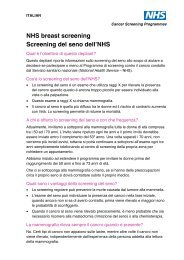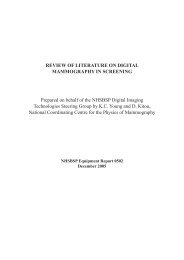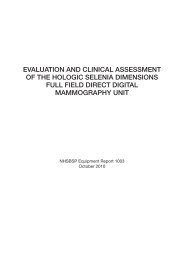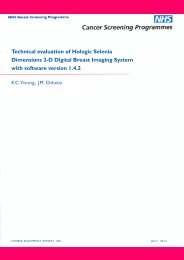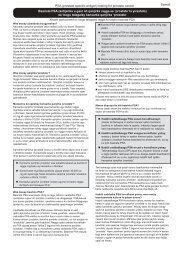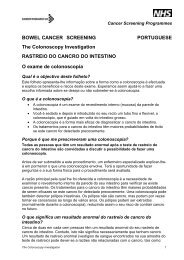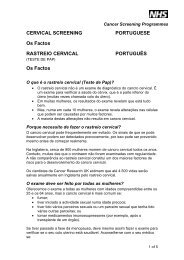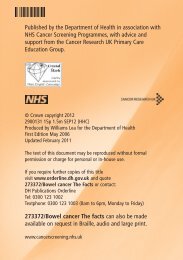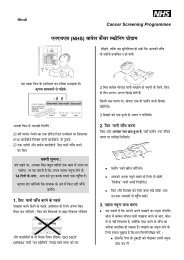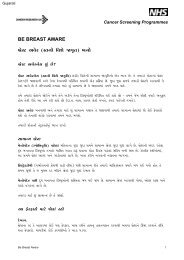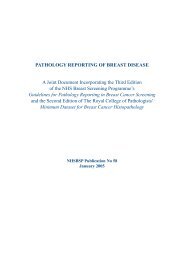reporting lesions in the nhs bowel cancer screening programme
reporting lesions in the nhs bowel cancer screening programme
reporting lesions in the nhs bowel cancer screening programme
Create successful ePaper yourself
Turn your PDF publications into a flip-book with our unique Google optimized e-Paper software.
14 | Report<strong>in</strong>g Lesions <strong>in</strong> <strong>the</strong> NHS Bowel Cancer Screen<strong>in</strong>g Programme<br />
4.5 Tumour grade<br />
Poorly differentiated carc<strong>in</strong>omas are identified ei<strong>the</strong>r by <strong>the</strong> presence of irregularly folded, distorted<br />
and often small tubules or by <strong>the</strong> lack of any tubular formation. In <strong>the</strong> absence of good evidence,<br />
we recommend that a grade of poor differentiation should be applied to a polyp <strong>cancer</strong> when any<br />
area of <strong>the</strong> lesion is considered to show poor differentiation. This differs from <strong>the</strong> recommendation<br />
for major colorectal <strong>cancer</strong> resections <strong>in</strong> <strong>the</strong> Royal College of Pathologists’ dataset, <strong>in</strong> which grade<br />
is determ<strong>in</strong>ed on <strong>the</strong> predom<strong>in</strong>ant area. Apply<strong>in</strong>g <strong>the</strong> ‘worst area’ criterion will allow all potentially<br />
poorly differentiated tumours to be identified for research <strong>in</strong>to which of <strong>the</strong> two approaches is better<br />
for identify<strong>in</strong>g T1 <strong>cancer</strong>s at <strong>in</strong>creased risk of lymph node metastases for major resection without<br />
expos<strong>in</strong>g such patients to <strong>the</strong> possibility of undertreatment. An early review of poorly differentiated<br />
pT1 cases will be undertaken.<br />
4.6 Lymphovascular <strong>in</strong>vasion<br />
Def<strong>in</strong>ite <strong>in</strong>vasion of endo<strong>the</strong>lium l<strong>in</strong>ed vascular spaces <strong>in</strong> <strong>the</strong> submucosa is generally regarded<br />
as a significant risk for lymph node or distant metastasis. Sometimes, retraction artefacts around<br />
tumour aggregates can make assessment uncerta<strong>in</strong>, <strong>in</strong> which case this uncerta<strong>in</strong>ty should be<br />
recorded and <strong>the</strong> observation <strong>in</strong>terpreted by <strong>the</strong> multidiscipl<strong>in</strong>ary team <strong>in</strong> light of any o<strong>the</strong>r adverse<br />
histological features.<br />
4.7 Marg<strong>in</strong> <strong>in</strong>volvement<br />
It is important to record whe<strong>the</strong>r <strong>the</strong> deep (<strong>in</strong>tramural) resection marg<strong>in</strong> is <strong>in</strong>volved by <strong>in</strong>vasive<br />
tumour (which may be an <strong>in</strong>dication for fur<strong>the</strong>r surgery) and whe<strong>the</strong>r <strong>the</strong> mucosal resection marg<strong>in</strong><br />
is <strong>in</strong>volved by carc<strong>in</strong>oma or pre-exist<strong>in</strong>g adenoma (<strong>in</strong> which case a fur<strong>the</strong>r local excision may be<br />
attempted).<br />
There has been considerable discussion and controversy <strong>in</strong> <strong>the</strong> literature over <strong>the</strong> degree of clearance<br />
that might be regarded as acceptable <strong>in</strong> tumours which extend close to <strong>the</strong> deep submucosal<br />
marg<strong>in</strong>. It is important that this is measured and recorded <strong>in</strong> <strong>the</strong> report. It is likely that most would<br />
regard a clearance of < 1 mm as an <strong>in</strong>dication for fur<strong>the</strong>r <strong>the</strong>rapy. However, some would use<br />
< 2 mm and a few < 5 mm.<br />
NHS BCSP September 2007



